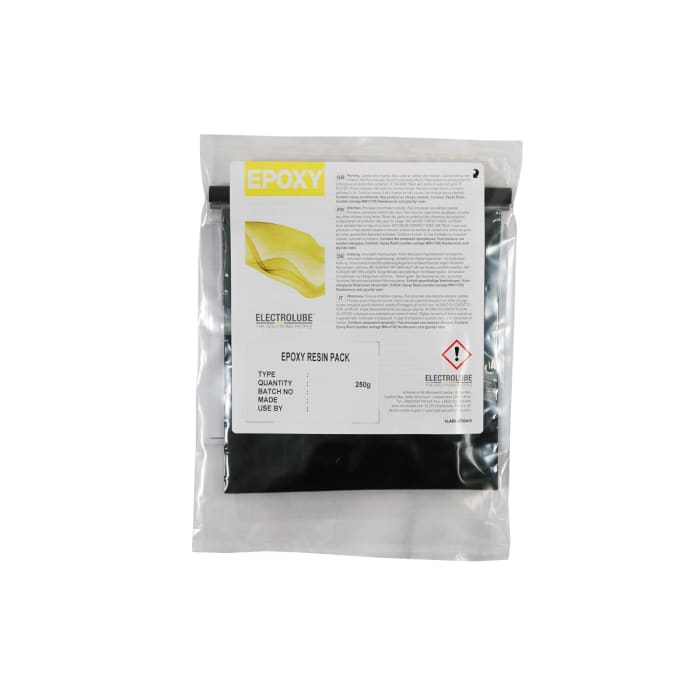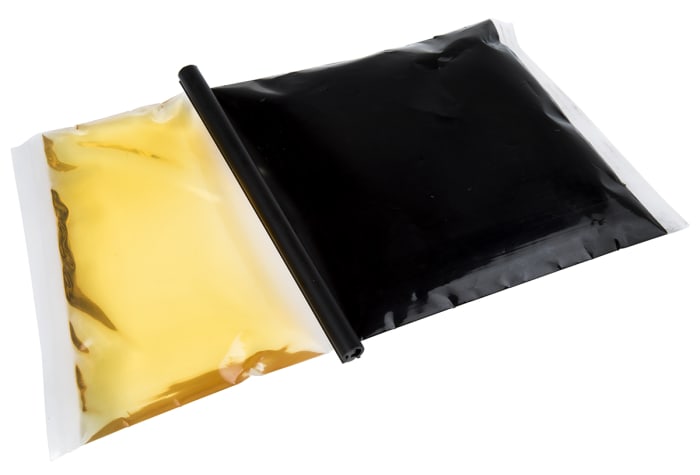Technical documents
Specifications
Brand
RS ProProduct Material
Epoxy
Package Type
Pack
Package Size
250 g
Special Properties
Chemical Resistance, Water Resistance
Cure Time
24 h
Hardness
80 Shore D
Thermal Conductivity
1.26W/mK
Colour
White
Maximum Operating Temperature
+130°C
Minimum Operating Temperature
-40°C
Volume Resistivity
1015Ω cm
Dielectric Strength
10kV/mm
Operating Temperature Range
-40 → +130 °C
Viscosity Measurement
16700 mPa/s at +23°C
Physical Form
Viscous Liquid
Chemical Composition
[(2Ethylhexyl)Oxy]Methyloxirane, 3-Epoxypropoxy)Phenyl]Propane, Bis[4-(2, Epoxy Resin, Zinc Oxide
Country of Origin
United Kingdom
Product details
RS PRO Thermally Conductive Twin-Pack Epoxy Resin Potting Compound
From RS PRO a high quality two-part white flame retardant epoxy resin potting compound. This epoxy potting compound provides a hard coating around your electrical components and offers excellent protection including resistance to chemicals and water. One of the main features of this epoxy resin is its high thermal conductivity and ability to dissipate or transfer heat making it ideal for use in LED applications. This compound uses a ’clean' type of flame retardant technology, this means that, when heated, it produces relatively low toxicity fumes and low smoke emission. The components that go to make up this epoxy resin system are supplied in convenient two-component packs, one containing the epoxy resin and the other containing the hardener. The contents are mixed together without opening the bag, simply remove the central clip and mix!
What is Epoxy Resin Potting Compound?
This epoxy resin is a type of electronic potting compound used for the encapsulation of PCBs (Printed Circuit Boards) and electronics components. Potting is a process of filling a complete electronic assembly with a solid or gelatinous compound. The potting compound, once applied, cured and hardened encases your electronics in a solid mass providing a barrier. This barrier protects and insulates the components from damaging environments including water, chemicals, heat and general contamination allowing them to maintain a high performance.
Features and Benefits
• High thermal conductivity of 1.26W/m.K
• Good chemical resistance and water resistance
• Good environmental protection
• Flame retardant to UL94 V-0 with a 'clean' flame retardant technology
• No abrasive fillers reducing wear on dispensing machinery
• White colour gives an attractive aesthetic finish
• ’Mix in the bag’ twin pack design reduces user contact and mess
What is this Epoxy Resin Potting Compound Used For?
This epoxy potting compound with its high thermal conductivity is ideal for use in thermal management solutions in LED applications as it dissipates heat away from the LED or unit. This compound can be used in both external and internal lighting systems.
What's in the Pack?
This white epoxy potting compound is supplied in twin pack format. One pack contains the epoxy resin and one contains the hardener both measured to the correct mix ratio. The two compartments are separated by a clip, which, when removed, forms one bag allowing you to mix the contents together. This design prevents air entrapment and allows the epoxy to be applied without any direct user contact avoiding excessive handling and mess. Each twin pack is supplied with full instructions for use. All packs are supplied with a desiccant for storage.
How do you Apply Potting Compound?
Before applying this epoxy potting compound it is important that any residue or contaminants are removed from the electronic components prior to potting. The electronic assembly is placed inside a mould called ’The pot’. This mould is then filled with the mixed potting compound that hardens and permanently protects the assembly. Circuit boards can also be potted and are often called ’potted’ PCBs. These circuit boards have high walled sides forming an enclosure with the mounted electronic components sitting inside. The potting compound is then poured into this enclosure.
Potting Compounds: Twin Packs
P.O.A.
1
P.O.A.
1
Stock information temporarily unavailable.
Please check again later.
| quantity | Unit price |
|---|---|
| 1 - 5 | P.O.A. |
| 6 - 11 | P.O.A. |
| 12 - 71 | P.O.A. |
| 72+ | P.O.A. |
Technical documents
Specifications
Brand
RS ProProduct Material
Epoxy
Package Type
Pack
Package Size
250 g
Special Properties
Chemical Resistance, Water Resistance
Cure Time
24 h
Hardness
80 Shore D
Thermal Conductivity
1.26W/mK
Colour
White
Maximum Operating Temperature
+130°C
Minimum Operating Temperature
-40°C
Volume Resistivity
1015Ω cm
Dielectric Strength
10kV/mm
Operating Temperature Range
-40 → +130 °C
Viscosity Measurement
16700 mPa/s at +23°C
Physical Form
Viscous Liquid
Chemical Composition
[(2Ethylhexyl)Oxy]Methyloxirane, 3-Epoxypropoxy)Phenyl]Propane, Bis[4-(2, Epoxy Resin, Zinc Oxide
Country of Origin
United Kingdom
Product details
RS PRO Thermally Conductive Twin-Pack Epoxy Resin Potting Compound
From RS PRO a high quality two-part white flame retardant epoxy resin potting compound. This epoxy potting compound provides a hard coating around your electrical components and offers excellent protection including resistance to chemicals and water. One of the main features of this epoxy resin is its high thermal conductivity and ability to dissipate or transfer heat making it ideal for use in LED applications. This compound uses a ’clean' type of flame retardant technology, this means that, when heated, it produces relatively low toxicity fumes and low smoke emission. The components that go to make up this epoxy resin system are supplied in convenient two-component packs, one containing the epoxy resin and the other containing the hardener. The contents are mixed together without opening the bag, simply remove the central clip and mix!
What is Epoxy Resin Potting Compound?
This epoxy resin is a type of electronic potting compound used for the encapsulation of PCBs (Printed Circuit Boards) and electronics components. Potting is a process of filling a complete electronic assembly with a solid or gelatinous compound. The potting compound, once applied, cured and hardened encases your electronics in a solid mass providing a barrier. This barrier protects and insulates the components from damaging environments including water, chemicals, heat and general contamination allowing them to maintain a high performance.
Features and Benefits
• High thermal conductivity of 1.26W/m.K
• Good chemical resistance and water resistance
• Good environmental protection
• Flame retardant to UL94 V-0 with a 'clean' flame retardant technology
• No abrasive fillers reducing wear on dispensing machinery
• White colour gives an attractive aesthetic finish
• ’Mix in the bag’ twin pack design reduces user contact and mess
What is this Epoxy Resin Potting Compound Used For?
This epoxy potting compound with its high thermal conductivity is ideal for use in thermal management solutions in LED applications as it dissipates heat away from the LED or unit. This compound can be used in both external and internal lighting systems.
What's in the Pack?
This white epoxy potting compound is supplied in twin pack format. One pack contains the epoxy resin and one contains the hardener both measured to the correct mix ratio. The two compartments are separated by a clip, which, when removed, forms one bag allowing you to mix the contents together. This design prevents air entrapment and allows the epoxy to be applied without any direct user contact avoiding excessive handling and mess. Each twin pack is supplied with full instructions for use. All packs are supplied with a desiccant for storage.
How do you Apply Potting Compound?
Before applying this epoxy potting compound it is important that any residue or contaminants are removed from the electronic components prior to potting. The electronic assembly is placed inside a mould called ’The pot’. This mould is then filled with the mixed potting compound that hardens and permanently protects the assembly. Circuit boards can also be potted and are often called ’potted’ PCBs. These circuit boards have high walled sides forming an enclosure with the mounted electronic components sitting inside. The potting compound is then poured into this enclosure.




